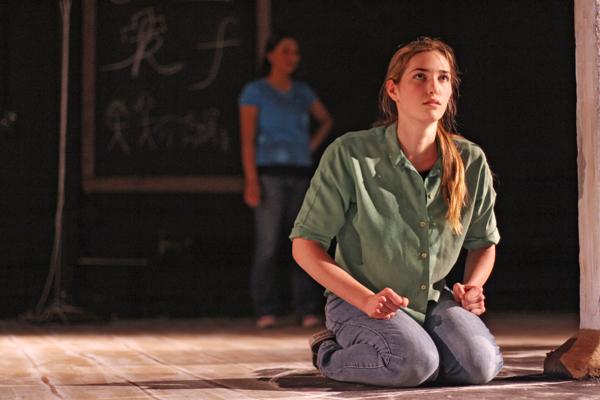
When Communication sophomore Alex Benjamin petitioned to direct “The Amish Project,” he didn’t realize he’d be broaching one of the most sensitive topics of 2013: school shootings. Though it was chosen by Spectrum Theatre Company well before the Newtown incident, the show took on a whole new meaning in light of the tragedy. Through its biting dialogue and alternative modes of storytelling, “The Amish Project” successfully tackles issues of grief, recovery and forgiveness in communities affected by school shootings.
The show opens with a solemn tribute to the major school shootings of the past century, alerting the audience to a pattern of violence that reaches far wider than the setting of the show. The story begins in Lancaster, Pa., where Amish and non-Amish people live in something like harmony until a man walks into an Amish schoolhouse and opens fire, shooting several young girls in the head before shooting himself.
The hour-long drama, written by New York playwright Jessica Dickey, premieres Thursday in Shanley Pavilion. For what it is, it’s done well. Benjamin impressively brings together what seem like incompatible modes of storytelling — montage, light shows, choreography, destruction of the fourth wall and even visual art — all while maintaining a sense of austerity and minimalism, allowing for a more visceral emotional experience for both actor and audience. The narrative of the shooting is slowly pieced together by little snippets of dialogue from Amish and non-Amish locals, all of whom vary in their degree of acceptance and recovery after the tragedy.
One of the most striking performances is that of Communication sophomore Katherine Seldin, who plays the shooter’s wife, Carol. The combination of scrutiny from her neighbors, the guilt of her husband’s actions and the confusion of being forgiven by the Amish community leave her in a state of mental turmoil akin to drowning. She acts accordingly, slowly losing composure throughout the piece in a way that effectively evokes the audience’s deepest sympathies.
A hat should also be tipped to Katherine Scott, a Communication sophomore and movement director for the show, who captures chaos through choreography with a surprising degree of tact.
Any time alternative modes of storytelling are involved, a production risks abstracting the subject — a particularly dangerous move when dealing with the topic of school violence, which is currently at the forefront of our nation’s reality. There are moments when the dialogue seems contrived, and it feels more like you’re watching a piece of performance art than a play. But all things considered, “Amish Project” pulls off a hard topic relatively well, highlighting the emotional turmoil and resolution in the aftermath of terror without undercutting the rawness of the tragedy itself. It sends an important message about forgiveness and healthy healing, while also providing lots of informative color and texture to the lives of the often-misunderstood Amish people. It’s a bit sad and a bit obscure, but probably still worth seeing if you’re prepared for it. I’d give it an A-.
“The Amish Project” runs 8 p.m. Thursday, 8 p.m. and 11 p.m. Friday and 2 p.m. and 8 p.m. Saturday at Shanley Pavilion.
